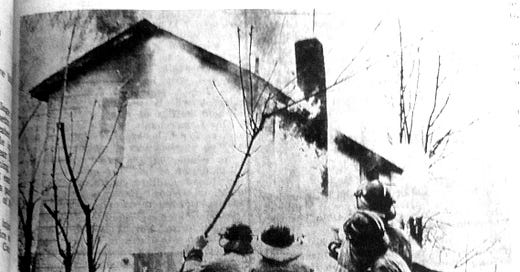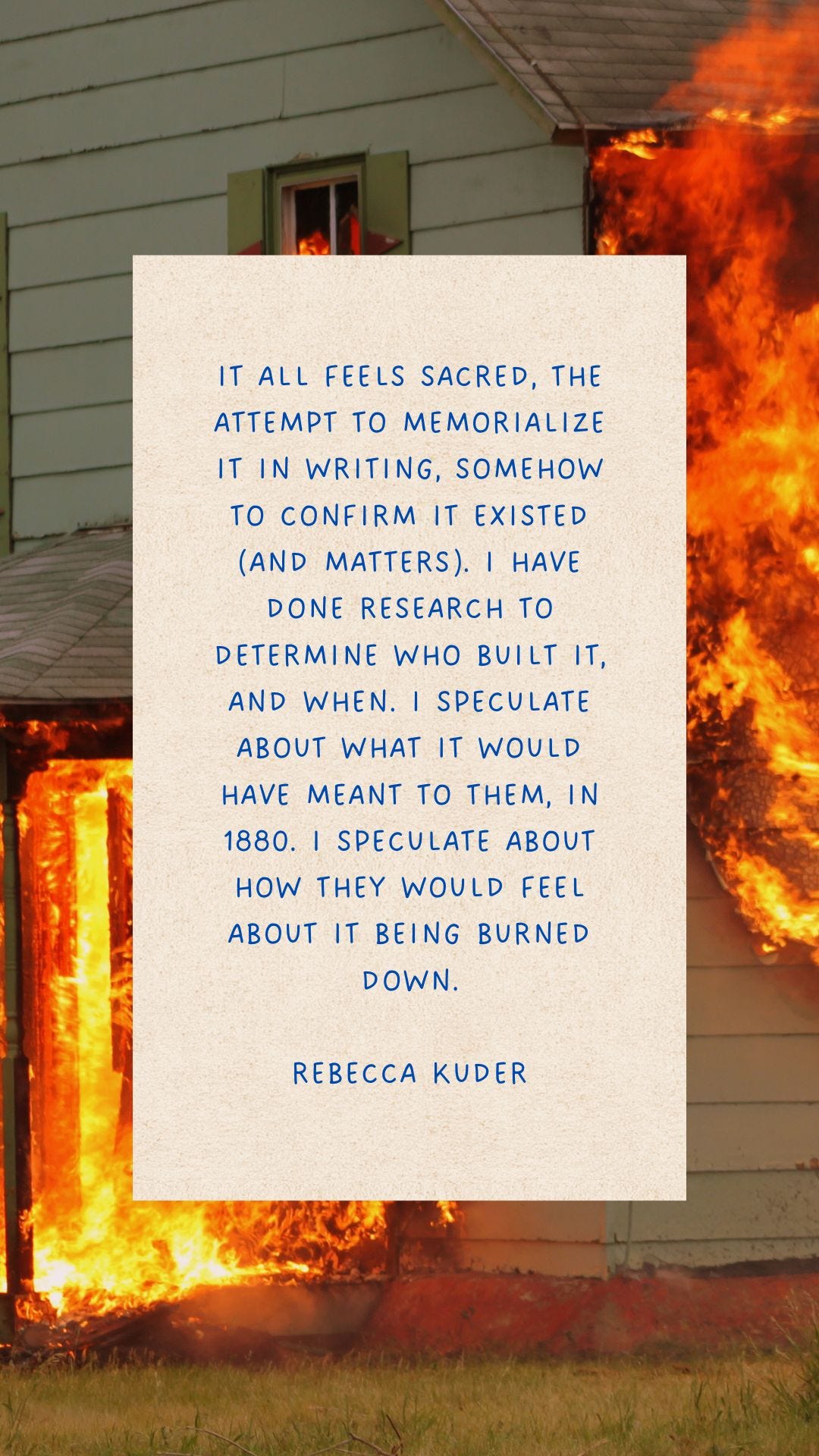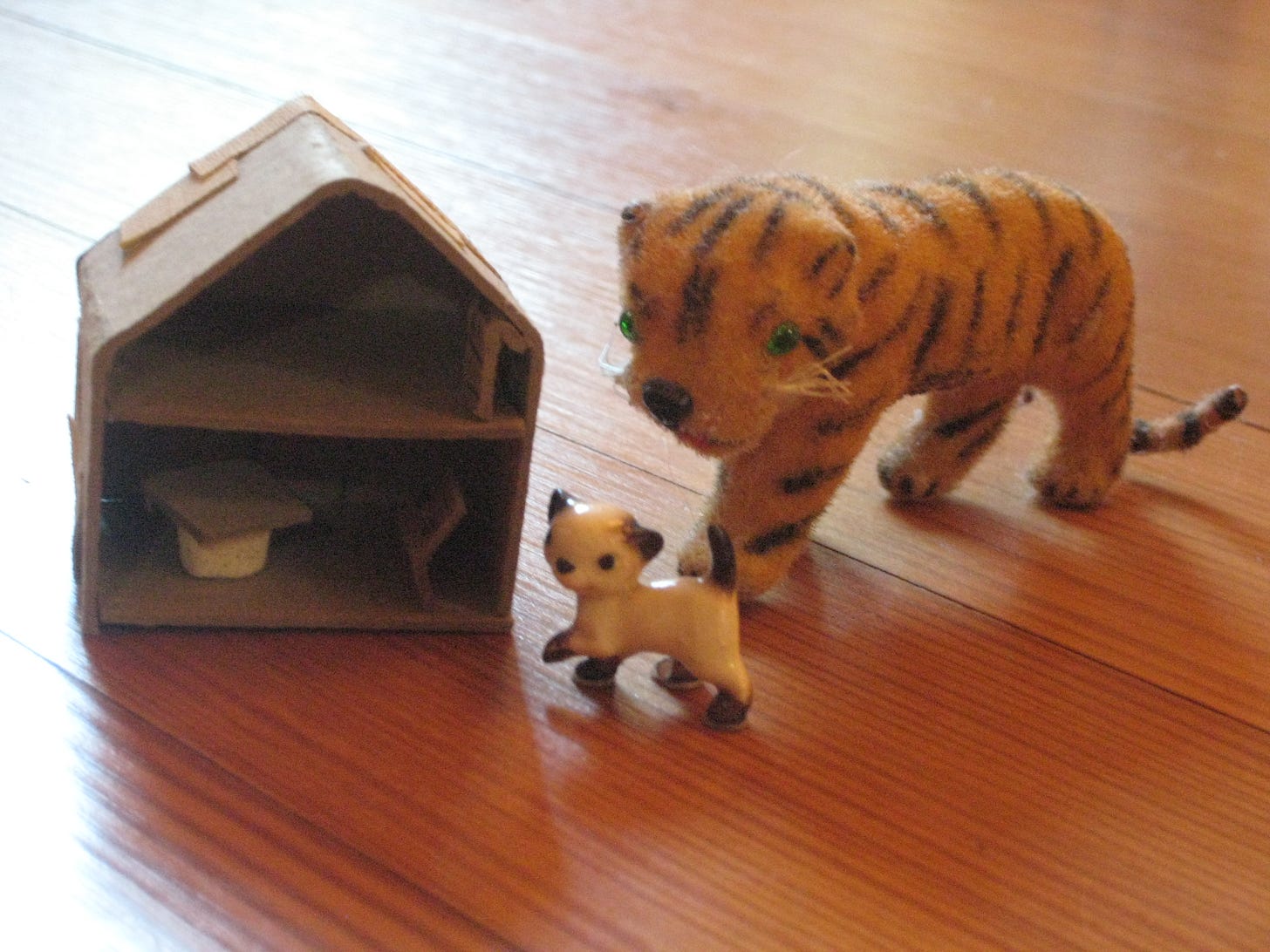Torched. Still Here. Rebecca Kuder on 318 West South College Street
When a burned-down childhood home remains a haunting presence. Or even a muse.
When I stumbled across Rebecca Kuder’s essay “A Trampoline” in the Los Angeles Review of Books, I immediately emailed her to tell her how much I loved it. In her poignant essay, Rebecca masterfully connects a chance meeting in a hotel elevator to her own life story.
Rebecca's family was forced out of their childhood home at 16 when the landlord sold it to the town. The town then used the house for a fire department training exercise, burning it to the ground. She still lives in Yellow Springs, Ohio, not far from where she grew up.
Read on to learn about the haunting legacy of a house that lingers in one’s memory, even after all that remains is ashes and dust.
Describe your childhood home in three words
Torched. Still Here.
What did it look like?
The house at 318 West South College Street was a two-story frame house, most likely built in 1880. It was dingy pink when my parents and I moved in. Later it was painted gray, with black shutters. It had a cement porch and out back, a shed, an old iron pump (that still worked), and a big field where we buried our cats when they died. The house stood next to Gaunt Park, which had baseball diamonds and two hills that still house a community swimming pool and the village’s water towers.
318 was a rather humble house, kind of funky, not very impressive, but very potent to me, especially because it’s gone.
What was your family situation like when you lived there?
We rented the house in 1969, when I was two-and-a-half years old. My parents were young hippies, and I recall a lot of era-appropriateness. A garden fertilized by elephant poop gathered in a trash can by my parents after the circus came to Gaunt Park. An incident when I was three or four and a couple of pals and I took off our clothes and covered our bodies with mud (made with water from the iron pump) then proclaimed ourselves the ‘mud monsters’, to surprise our folks. Friends and relations, at intervals, came to live at 318 and sometimes stayed for long spans of time.
When I was seven, my parents broke up, and my dad moved out.
When I was sixteen, our landlord sold the property to the town, and the town wanted a new soccer field at the park. We were forced to move out, and the fire department performed a planned burn of my childhood home.
What is your earliest memory inside or around the house?
Memory can be so slippery. I’m not sure what I recall from family stories, or photographs, or actual memory, but one thing that comes to mind: when I was little—not sure how old—I planned to perform some trick for a waiting friend, and because I needed a running start, I ran from my room, down the stairs, through the house, and banged through the glass storm door and somehow, though glass shattered all around me, I wasn’t shredded and only needed three stitches under my arm.
I wasn’t particularly accident prone, but many of the memories (that abide) have to do with injuries, like when I was five-ish, at play on the landing upstairs, and fell or somersaulted down sixteen steps, and emerged with only a bruise on my forehead.
The memoir I’m writing about 318 (and how it haunts me) deals with the impact the house had on my body, and a house as body, a container for stories and trauma. I’m obsessed with how the body stores memories, outside of linear time. (I often labor to recover facts, in a sort of de-gaslighting process: What can I remember? And can I trust what I remember?) There’s a thing we must remind ourselves, in trauma recovery, which goes: I feel what I feel and I know what I know. Sometimes writing this memoir feels like one big struggle of affirmation.
There’s a thing we must remind ourselves, in trauma recovery, which goes: I feel what I feel and I know what I know. Sometimes writing this memoir feels like one big struggle of affirmation.
What is one room or space that remains the most vivid in your memory?
My bedroom: I loved that room. At night I watched car lights dance across the walls. The room was big and had three windows and two doors, means of escape—one to the landing, one to the closet. I loved how mine it felt.
The room had a brown braided rug, and a bunk bed, and Leo the Lion and Snoopy and Woodstock and lots more stuffed animals. A stuffed red monster with loopy yarn hair that my teacher made for me (she made each kid a different, wild monster). A dollhouse full of little Steiff and Schuco mohair bears, and other sweet, miniature inhabitants—mostly animals, rather than dolls.
The deep, walk-in closet we called my cave. I recall a pillow and a lamp in there, a little sanctuary.
What’s one object from your childhood home that you wish you still had?
I kept so, so much from childhood, and maybe clung to the beloved things because 318 the house is gone. But one thing I don’t have is the painted bookshelf I used as a dollhouse. I still have the inhabitants1 and their many (many) possessions, which are now installed in a bigger bookshelf—which takes up a good deal of space in my small office. I look at it from where I sit now, typing. But I would love to have their actual ‘house’. I don’t know what happened to that original bookshelf. It would be reassuring if at least my little bears had their home, still. If I had known 318 would haunt me now, would I have kept more from inside its walls?
How did living in that home influence who you are today?
Living in that home is wrapped up in my sense of loss (lost the house, the foundation of my youth), which leaves me with a weird echo that feels like abandonment. It was great to live beside the park, the swimming and sledding and elephant poo, but then they burned it down.
There are named College streets in every direction here. People always get confused. My husband and daughter and I now live on a different College street. Our mail is sometimes delivered one street over. West South, West Center, West North. East South, East Center, East North. The College streets are how I learned directions. Even now, to conjure my inner compass, I close my eyes and imagine I’m there, at 318, then I know where I am. Know which way to go.
Gaunt Park is still vibrant. A community swimming pool crowns a small hill, where children sled in winter and locals watch fireworks in July. At the park are two water towers, and a field no longer for soccer, but now for baseball. It’s an expanse of green where, when I was a kid, we won carnival goldfish and watched circus elephants. Yes: when the circus came to town, it landed beside our house. As I got older, I spent long summer days at the pool. It was a good place to grow up.
Have you ever been back? Why or why not?
Yes: My body has been back repeatedly to the place where the house once stood. I live a couple of blocks away, and often walk or drive past. Sometimes it’s incidental, to get from one part of town to another. Sometimes I’ve gone there to put a decoration on the now-huge evergreen that was once our live Christmas tree (which the village staff moved to the edge of the property, before they torched our house). Sometimes I’ve gone there with a blanket, to lie on the ground and write.
Sometimes I go back in dreams, and the house is intact, just as it was before we moved out, before they burned it down. Sometimes it’s for sale and I’m aiming to buy it ‘back’, though in fact, we never owned it.
And often, I go back to the house, where it lives in the liminal space of writing.
Also, no: I haven’t been back because I can’t go back, because the house is gone. (Maybe this duality helps explain the haunt.)
Does this home ever show up in your work?
Almost constantly, in some way or other.
In 2017, after decades of blurry memory about the fire, I went to the local newspaper and searched the archives, found the front-page story. “BATTLING A BLAZE they set themselves, members of the Yellow Springs fire department staged a training exercise...to make way for new soccer fields at Gaunt Park.”
That house—or a version, an echo of it, of what it means—shows up in almost everything I write. Two of my essays (here and here) appear in the memoir about the house. Beyond the memoir, the house and its metaphoric detritus shows up in a novel I’m revising, and in short stories. I wrote a play about going back to the location, remembering and then re-membering, conjuring it, and exorcising the Big Bag Wolf of my past—a reclamation of the house (and my body).
Any closing thoughts you’d like to share?
My daughter has said that 318 is my muse. I think she’s right. It all feels sacred, the attempt to memorialize it in writing, somehow to confirm it existed (and matters). I have done research to determine who built it, and when. I speculate about what it would have meant to them, in 1880. I speculate about how they would feel about it being burned down.
Here’s an excerpt from the memoir:
Sometime around 1880 or 1881, John H. Vincent built or hired someone to build a house, could not have imagined skin-kneed, curling-ironed me, a hundred years later. No more than I can imagine the world a hundred years from now. But the house he made housed me. Thank you, Mr. Vincent. The tendril of our connection is a spine, a spindle of green, a green shoot, alive and still relevant. It exists.
Dear John H. Vincent: Someday no one will remember. Someday, we won’t be able to talk like this, to even connect our green tendril stories to each other, back through time. Some day we won’t have to struggle so hard to remember.
About Rebecca Kuder
Rebecca Kuder’s debut novel, The Eight Mile Suspended Carnival, was published in 2021 by What Books Press. Her book, Dear Inner Critic: a self-doubt activity book, was published in 2024 by Literary Kitchen. Her stories and essays have appeared in Los Angeles Review of Books; Hags on Fire; Bayou Magazine; Shadows and Tall Trees; Year’s Best Weird Fiction; The Rumpus; Crooked Houses; and elsewhere. She holds an MFA in Creative Writing from Antioch University Los Angeles and received an individual artist excellence award from the Ohio Arts Council. Rebecca lives in Yellow Springs, Ohio, with the writer Robert Freeman Wexler and their child. Learn more at Rebecca’s website.
Current inhabitants: at least 18 bears; 4 each (rabbits, giraffes, and dogs); 3 monkeys; 2 each (boars, mice, koalas, birds, trolls, parrots); 1 each (camel, seal, raccoon, deer, tiger, frog, etc. etc. etc.)








I'm glad you found and shared this post. I was born in Yellow Springs and spent my first six years there. My earliest memories are from our house on Limestone Street.